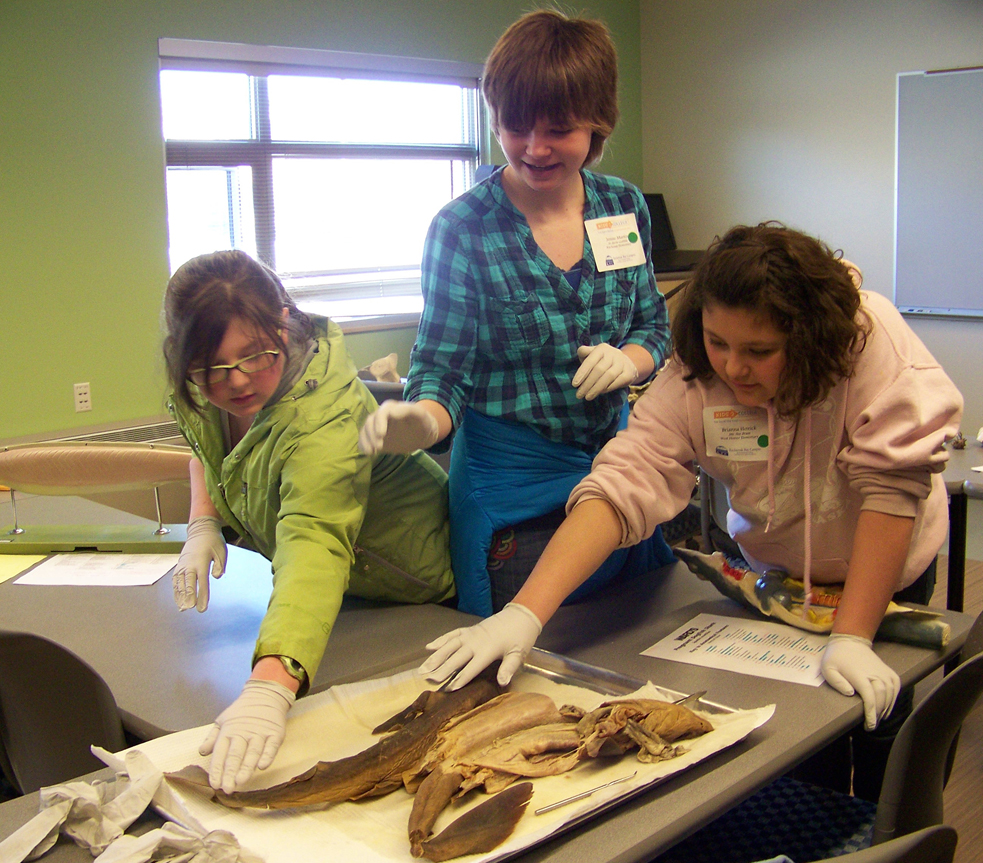Here, the remains of a pregnant dogfish shark. There, the dissected pieces of a squid. Over there, whale bones. In a jar, a sand dollar. On a desk, the curled-up shape of a sea star. And there, a sea otter pelt.
Explanations from biology professor Debbie Boege-Tobin of Kachemak Bay Campus, Kenai Peninsula College-University of Alaska Anchorage, directed students’ attention from one specimen to the next last Friday. Some asked questions. Some blocked their noses against the fishy smell filling the room. When Boege-Tobin gave the OK, the students donned gloves and gave the specimens a closer inspection.
What set the “Exploring Marine Biology” class apart wasn’t the subject matter, however, but the age of the students: fifth- and sixth-graders from Chapman School in Anchor Point and West Homer Elementary School who were taking a giant step past middle and high school to participate in Kids2College.
“The students were really looking forward to this,” said Shirlie Gribble, sixth-grade teacher at WHES.
Teacher Mary Simondson’s students from Chapman were equally excited.
“We had a great trip,” Simondson told the Homer News.
Kids2College was offered through a partnership between KBC and the Alaska Commission on Postsecondary Education. Chapman and WHES were invited to participate because they were the area schools with the most fifth- and sixth-graders, for which the Kids2College program is designed, and because they are Title I schools.
“Kids2College offers a series of six college awareness lessons the kids participate in prior to their day at college,” said Carol Swartz, KBC director. “Each classroom teacher chose which lessons they would like to give themselves and which ones they would like the college to help with. Kim Frost, our KBC student services coordinator, conducted many of the activities in their classrooms.”
At WHES, Frost taught five lessons centering on education options, career exploration, financing college, identifying types of learning and connecting college and careers. It ended with a panel of community members representing various careers, part of a career day at the school.
Similarly, Chapman students prepared for the campus visit through six lessons addressing postsecondary options, career exploration, individual skills and learning styles, and offered an opportunity for the youngsters to meet representatives of different careers from Homer and Anchor Point.
Their one-day college experience gave the 74 participating fifth- and sixth-graders a sampling of what college is like. In addition to Boege-Tobin’s class, others included:
• “Discovering Alaska,” using maps to understand our place, taught by history and political science professor Michael Hawfield;
• “The Magic of the Mind,” exploring the world of sensation and perception by demonstrating its limitations, taught by psychology professor Brian Partridge;
• “Say What? The Power of Nonverbal Communication,” learning that how you say something carries far more weight than what you say, taught by composition and communications professor Beth Graber;
• “Saywo!: An Anthropological Preview of West African Cultures,” designed to inspire students to consider studying anthropology as a gateway to work and travel all over the world, taught by anthropology and liberal science professor Cathy Knott.
“We participated in a similar program, ‘I’m Going to College,’ for the first time in 2011,” said Swartz. “The experience was tremendous and our feedback from the schools and kids was extremely positive, so we decided to try it again this year with Kids2College.”
In addition to KBC, the Alaska Commission on Postsecondary Education worked with schools in 11 other communities, for a total of 2,200 fifth- and sixth-graders. The Kids2College program also is used in 27 other states. It is sponsored by the Sallie Mae Fund, a charitable organization whose mission is to increase college access for American students.
For KBC, participating in Kids2College fits with the college’s mission to promote higher education and job opportunities, said Swartz.
Gribble said the benefit for her students “has been finding out about how to get scholarships; what is available to them after high school graduation, traditional as well as nontraditional programs and opportunities; to begin thinking about what they have a passion for (this will change many times); and begin the dialogue at home, if it hasn’t already started, about education after high school.”
Following their introduction to college, the youngsters will combine what they’ve learned and experienced with plans they are beginning to make for their own futures.
“Each student will have an opportunity to research a career of their choice and present their job to a panel of their peers,” said Simondson.
To help them on their way, the students were given backpacks from KPC containing study materials, Alaska college information and a piggybank including their first dollar of college savings.


